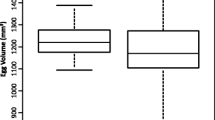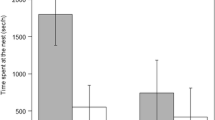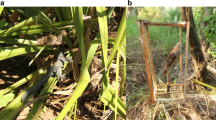Summary
White-winged choughs are a cooperatively breeding species which provide parental care to their young over an entire year. I traced the reproductive success of groups of white-winged choughs from the start of one breeding season to the next over 3 years. I examined the effect of helper number on timing of breeding, the success of each effort, the number of efforts made in a season, and the final reproductive success at the end of each year. Timing of commencement of breeding varied between years but was not related to group size. Early broods were not more successful than late broods. Nest building (July–September) commenced earlier in years which had high rainfall in July; choughs rely on rainfall for supplies of mud for nest construction. Most nest failures occurred gradually and were attributed to starvation of nestlings, although some sudden failures were attributed to predation. Large groups have more young by the beginning of the following season; this is due to higher fledging success and a greater likelihood of having second broods. Disappearance of young after fledging and during the transition to independence was not dependent on group size. Only groups of seven and above produce more than one young on average over the entire year; choughs provide one of the most marked cases for helpers enhancing the reproductive success of breeders. Large groups are virtually guaranteed of reproductive success over the whole year and grow more quickly than small groups. These results highlight the need to consider the effect of helpers over the entire period of reproduction and care of young, rather than just at fledging.
Similar content being viewed by others
References
Austad, S. N. and Rabenold, K. N. (1985) Reproductive enhancement by helpers and an experimental examination of its mechanism in the Bicolored Wren: a facultatively communal breeder.Behav. Ecol. Sociobiol. 17, 19–27.
Brown, J. L. (1974) Alternate routes to sociality in jays — with a theory for the evolution of altruism and communal breeding.Am. Zool. 14, 63–89.
Brown, J. L. (1987)Helping and Communal Breeding in Birds. Ecology and Evolution. Princeton University Press, Princeton, NJ.
Brown, J. L. and Brown, E. R. (1981) Kin selection and individual selection in Babblers. InNatural Selection and Social Behaviour: Recent Research and New Theory (R. D. Alexander and D. W. Tinkle, eds) pp. 244–56. Chiron, NY, USA.
Brown, J. L., Brown, E. R., Brown, S. D. and Dow, D. D. (1982) Helpers: effects of experimental removal on reproductive success.Science 215, 421–2.
Craig, J. L. (1980) Breeding success of a common gallinule.Behav. Ecol. Sociobiol. 6, 289–95.
Emlen, S. T. (1982) The evolution of helping 1. An ecological constraints model.Am. Nat. 119, 29–39.
Emlen, S. T. and Wrege, P. H. (1989) A test of alternate hypotheses for helping behavior in white-fronted bee-eaters of Kenya.Behav. Ecol. Sociobiol. 25, 303–19.
Fitzpatrick, J. W. and Woolfenden, G. E. (1988) Components of lifetime reproductive success in the Florida scrub jay. InReproductive Success. Studies of Individual Variation in Contrasting Breeding Systems (T. H. Clutton-brock, ed.) pp. 305–20. University of Chicago Press, Chicago, IL, USA.
Gaston, A. J. (1978) Demography of the jungle babblerTurdoides striatus.J. Anim. Ecol. 47, 845–70.
Hamilton, W. D. (1964) The genetical evolution of social behaviour 1 and 2.J. Theor. Biol. 7, 1–52.
Heinsohn, R. G. (1987) Age-dependent vigilance in winter aggregations of cooperatively breeding white-winged choughs (Corcorax melanorhamphos).Behav. Ecol. Sociobiol. 20, 303–6.
Heinsohn, R. G. (1988) Intergroup ovicide and nest destruction in cooperatively breeding white-winged choughs.Anim. Behav. 36, 1856–8.
Heinsohn, R. G. (1991) Slow learning of foraging skills and extended parental care in cooperatively breeding white-winged choughs.Amer. Nat. 137, 864–81.
Heinsohn, R. G., Cockburn, A. and Cunningham, R. B. (1988) Foraging, delayed maturation, and advantages of cooperative breeding in white-winged choughs,Corcorax melanorhamphos.Ethology 77, 177–6.
Heinsohn, R. G. and Cunningham, R. B. (1992) Brood reduction, hatching asynchrony, and obligate cooperative breeding in white-winged choughs.Behav. Ecol. Sociobiol. (in press).
Koenig, W. D. (1981) Reproductive success, group size, and the evolution of cooperative breeding in the Acorn Woodpecker.Am. Nat. 117, 421–43.
Koenig, W. D. and Mumme, R. L. (1987)Population Ecology of the Cooperatively Breeding Acorn Woodpecker. Princeton University Press, Princeton, NJ, USA.
Ligon, J. D. (1981) Demographic patterns and communal breeding in the Green WoodhoopoePhoeniculus purpureus. InNatural Selection and Social Behavior (R. D. Alexander and D. W. Tinkle, eds) pp. 231–43 Chiron, NY, USA.
Ligon, J. D. and Ligon, S. H. (1983) Reciprocity in the green woodhoopoe (Phoeniculus purpureus).Anim. Behav. 31, 480–9.
Ligon, J. D. and Ligon, S. H. (1988) Territory quality: key determinant of fitness in the group-living green woodhoopoe. InThe Ecology of Social Evolution (C. Slobodchikoff, ed) pp. 229–53. Academic Press, NY, USA.
Pizzey, G. (1980)A Field Guide to the Birds of Australia. Collins, Sydney.
Price, T., Kirkpatrick, M. and Arnold, S. J. (1988) Directional selection and the evolution of breeding date in birds.Science 240, 798–9.
Rabenold, K. N. (1984) Cooperative enhancement of reproductive success in tropical wren societies.Ecology 65, 871–85.
Reyer, H-U. (1980) Flexible helper structure as an ecological adaptation in the pied kingfisher (Ceryle rudis rudis L.).Behav. Ecol. Sociobiol. 6, 219–27.
Reyer, H-U., Dittami, J. P. and Hall, M. R. (1986) Avian helpers at the nest: are they psychologically castrated?Ethology 71, 216–28.
Ridpath, M. G. (1972) The Tasmanian Native Hen,Tribonix morterii 2. The individual, the group, and the population.CSIRO Wildlife Res. 17, 53–90.
Rowley, I. (1965) The life history of the Superb Blue Wren,Malurus cyaneus.Emu 64, 251–97.
Rowley, I. (1978) Communal activities among white-winged choughsCorcorax melanorhamphus.Ibis 120, 1–20.
Russell, E. M. and Rowley, I. (1988) Helper contributions to reproductive success in the Splendid FairywrenMalurus splendens.Behav. Ecol. Sociobiol. 22, 131–40.
Stacey, P. B. (1979) Habitat saturation and communal breeding in the Acorn Woodpecker.Anim. Behav. 27, 1153–66.
Stacey, R. B. and Ligon, J. D. (1987) Territory quality and dispersal options in the acorn woodpecker, and a challenge to the habitat-saturation model of cooperative breeding.Amer. Nat. 130, 654–76.
Wiley, R. H. and Rabenold, K. N. (1984) The evolution of cooperative breeding by delayed reciprocity and queuing for favorable social position.Evolution 38, 609–21.
Woolfenden, G. E. and Fitzpatrick, J. W. (1984)The Florida Scrub Jay. Demography of a Cooperative-breeding Bird. Princeton University Press, Princeton, NJ, USA.
Wyndam, E. (1986) Length of birds' breeding seasons.Am. Nat. 128, 155–64.
Zahavi, A. (1974) Communal nesting by the Arabian babbler.Ibis,116, 84–7.
Zahavi, A. (1989) Arabian babbler. InLifetime Reproduction in Birds (I. Newton, ed.). pp. 253–76. Academic Press, London, UK.
Author information
Authors and Affiliations
Rights and permissions
About this article
Cite this article
Heinsohn, R.G. Cooperative enhancement of reproductive success in white-winged choughs. Evol Ecol 6, 97–114 (1992). https://doi.org/10.1007/BF02270705
Issue Date:
DOI: https://doi.org/10.1007/BF02270705




